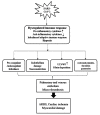COVID-19 Severity: Lung-Heart Interplay
- PMID: 33305712
- PMCID: PMC8762151
- DOI: 10.2174/1573403X16999201210200614
COVID-19 Severity: Lung-Heart Interplay
Abstract
In December 2019, a novel COVID-19 infection caused by SARS-CoV-2 has emerged as a global emergency. In a few months, the pathogen has infected millions of people in the world. Primarily SARS-CoV-2 infects the pulmonary system which ultimately leads to ARDS and lung failure. The majority of patients develop milder symptoms but the infection turns severe in a huge number of people, which ultimately results in enhanced mortality in COVID-19 patients. Co-morbid conditions, primarily cardiovascular complications and diabetes, have been reported to show a strong correlation with COVID-19 severity. Further, the onset of myocardial injury secondary to pulmonary damage has been observed in critically ill patients who have never reported heart-related ailments before. Due to drastic health risks associated with virus infection, the unprecedented disruption in normal business throughout the world has caused economic misery. Apparently, newer treatments are urgently needed to combat the virus particularly to reduce the severity burden. Therefore, understanding the crosstalk between lung and heart during COVID-19 might give us better clarity for early diagnosis followed by appropriate treatment in patients with the likelihood of developing severe symptoms. Accordingly, the present review highlights the potential mechanisms that may explain the crosstalk between lung and heart so that effective treatment/management strategies can be evolved swiftly in this direction.
Keywords: ARDS; COVID-19; SARS-CoV-2; cardiovascular disease; lung-heart interplay.; respiratory failure.
Copyright© Bentham Science Publishers; For any queries, please email at epub@benthamscience.net.
Figures


Similar articles
-
COVID-19 and cardiac injury: clinical manifestations, biomarkers, mechanisms, diagnosis, treatment, and follow up.Expert Rev Anti Infect Ther. 2021 Mar;19(3):345-357. doi: 10.1080/14787210.2020.1822737. Epub 2020 Sep 28. Expert Rev Anti Infect Ther. 2021. PMID: 32921216 Review.
-
How to reduce the likelihood of coronavirus-19 (CoV-19 or SARS-CoV-2) infection and lung inflammation mediated by IL-1.J Biol Regul Homeost Agents. 2020 March-April,;34(2):333-338. doi: 10.23812/Editorial-Conti-2. J Biol Regul Homeost Agents. 2020. PMID: 32228825
-
Pathogenesis-directed therapy of 2019 novel coronavirus disease.J Med Virol. 2021 Mar;93(3):1320-1342. doi: 10.1002/jmv.26610. Epub 2020 Nov 10. J Med Virol. 2021. PMID: 33073355 Review.
-
The British variant of the new coronavirus-19 (Sars-Cov-2) should not create a vaccine problem.J Biol Regul Homeost Agents. 2021 Jan-Feb;35(1):1-4. doi: 10.23812/21-3-E. J Biol Regul Homeost Agents. 2021. PMID: 33377359
-
Single-cell RNA analysis on ACE2 expression provides insights into SARS-CoV-2 potential entry into the bloodstream and heart injury.J Cell Physiol. 2020 Dec;235(12):9884-9894. doi: 10.1002/jcp.29802. Epub 2020 Jun 8. J Cell Physiol. 2020. PMID: 32510598 Free PMC article.
Cited by
-
Heart-lung crosstalk in acute respiratory distress syndrome.Front Physiol. 2024 Oct 18;15:1478514. doi: 10.3389/fphys.2024.1478514. eCollection 2024. Front Physiol. 2024. PMID: 39493867 Free PMC article. Review.
-
Noteworthy impacts of COVID-19 pandemic on cancer screening: A systematic review.Fundam Res. 2024 Feb 8;4(3):484-494. doi: 10.1016/j.fmre.2023.12.016. eCollection 2024 May. Fundam Res. 2024. PMID: 38933198 Free PMC article. Review.
-
The Significance of Low Magnesium Levels in COVID-19 Patients.Medicina (Kaunas). 2023 Jan 31;59(2):279. doi: 10.3390/medicina59020279. Medicina (Kaunas). 2023. PMID: 36837480 Free PMC article. Review.
-
The cross-talk of lung and heart complications in COVID-19: Endothelial cells dysfunction, thrombosis, and treatment.Front Cardiovasc Med. 2022 Aug 5;9:957006. doi: 10.3389/fcvm.2022.957006. eCollection 2022. Front Cardiovasc Med. 2022. PMID: 35990983 Free PMC article. Review.
-
Efficacy of Sacubitril Valsartan sodium tablets in patients with heart failure combined with pulmonary infection and long-term recurrence rate.Am J Transl Res. 2024 Aug 15;16(8):3742-3750. doi: 10.62347/ESYO5136. eCollection 2024. Am J Transl Res. 2024. PMID: 39262724 Free PMC article.
References
-
- Worldometer COVID-19 coronavirus pandemic. Available from: https://www.worldometers.info/coronavirus/. [Accessed Oct 19, 2020]
Publication types
MeSH terms
Grants and funding
LinkOut - more resources
Full Text Sources
Medical
Miscellaneous
